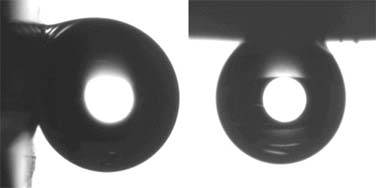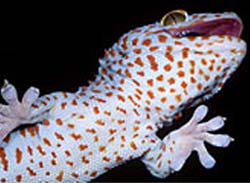
Water droplets always cling to the surface of the aligned polystyrene nanotube films fabricated by CAS researchers regardless of the angle at which the surface is held.

Geckos are lizards with an impressive capacity to walk upside down on almost any surface, using just the attractive forces created by their feet to hold on. Borrowing the miraculous mechanism of the creature's feet, CAS researchers have succeeded in producing superhydrophobic nanotube films noted for their high adhesion.
How can geckos run upside down on polished glass? Some think that the creatures have suction cups on their feet, others say it is due to electrostatic attraction, and still others believe that they use hooks or claws or secrete glue on their feet. The question kept puzzling people for years until 2000, when a study published in
Nature found that amazing climbing ability of geckos can be attributed to their nearly five hundred thousand tiny elastic hairs called setae, each of which branches at the end into up to 1,000 even tinier fibers called spatulas. The research shows that the fine structure enables the contact between the setae and surface close enough to effect van der Waals forces - the weak attraction that molecules have for one another when they are brought very, very close together. Although each hair exerts a tiny force on the surface, when being added together, they enable geckos to hang off surfaces at any angle.
Using a simple approach of template-directed assembly, Prof. Jiang Lei, Dr. Feng Lin and colleagues from the Key Laboratory of Organic Solids at the CAS Institute of Chemistry fabricated aligned polystyrene nanotube films to mimic the gecko's setae and spatulas. They found that the surface formed has the sticking qualities of a gecko's foot. Their experiments show, as published online on 30 Jun 2005 by
Advanced Materials, that water droplets always cling to the surface regardless of the angle at which the surface was held and the adhesive strength of the surface increased with increasing density of the nanotubes.
Another feature of the nanotube films is that the surface is extremely water-repellent. The water contact angle for the nanotube array was 162 degrees, compared with 95 degrees for a smooth polystyrene surface. As a measure of surface wettability, the higher the contact angle, the more hydrophobic a substance would be, according to scientists. Human skin, for example, is a hydrophobic surface with a contact angle of about 90 degrees. Bird feathers and lotus leaves are considered superhydrophobic, with contact angles of 150 and 170 degrees, respectively.
Keeping these features in mind, researchers expect that the artificial sticky superhydrophobic nanotubes may have future applications in transferring water droplets to a hydrophilic surface without any loss of fluid or introduction of contamination for practical fluid manipulation.








